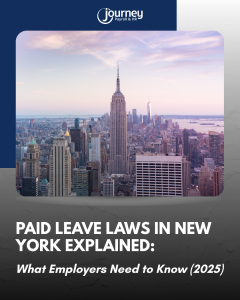If you have employees in New York, paid leave isn’t just a nice-to-have it’s table stakes for compliance and retention. 2025 brought a few meaningful updates, and there are also local rules in places like New York City and Westchester County that sit on top of the state baseline. This guide breaks down what’s required and how to get your policy and payroll settings right.
 What changed in 2025?
What changed in 2025?
Two big things:
- Statewide paid prenatal leave arrived.
New York now guarantees pregnant employees 20 hours of paid prenatal personal leave each 52-week period separate from, and in addition to, ordinary sick/safe leave. Effective January 1, 2025.
Leave must be used in hourly increments; it covers fertility treatments and end-of-pregnancy appointments (but not postpartum visits), and employers cannot require medical details to approve leave. - Paid Family Leave (PFL) amounts refreshed.
Employees can still take up to 12 weeks at 67% of their average weekly wage, but the 2025 maximum weekly benefit is $1,177.32.
Employee payroll contributions are 0.388% of wages, capped at $354.53 per year.
The 2025 State Average Weekly Wage (SAWW) used for calculations is $1,757.19.
The statewide foundation
1) New York Paid Sick & Safe Leave (NYSSL)
New York requires sick and “safe” leave (for issues like domestic violence or stalking) for most private employers. Leave can be accrued at 1 hour per 30 hours worked or front-loaded at the start of the year.
Annual entitlements depend on size and net income:
- 0–4 employees + prior-year net income ≤ $1 million → up to 40 hours unpaid
- 0–4 employees + prior-year net income > $1 million → up to 40 hours paid
- 5–99 employees → up to 40 hours paid
- 100+ employees → up to 56 hours paid
Employer move: Document whether you accrue or front-load, your minimum usable increment (consistent with the law), and how employees request leave. Train supervisors not to ask for medical documentation unless the absence meets the legal threshold—state: 3 or more consecutive days; NYC: more than 3 consecutive workdays and only if your written policy allows it.
2) Paid Prenatal Personal Leave (new in 2025)
This is a stand-alone entitlement of 20 paid hours for prenatal care (exams, monitoring, fertility treatment, and end-of-pregnancy visits). It’s in addition to NYSSL and can be taken in hourly chunks.
Pay at the employee’s regular rate or applicable minimum wage, whichever is higher. The 52-week period starts the first time prenatal leave is used.
Employer move: Update your handbook and time-off codes so employees and payroll both treat prenatal time correctly.
3) New York Paid Family Leave (NYPFL)
Paid Family Leave remains an employee-funded insurance benefit with job protection and continued health-coverage during leave. Qualifying reasons include:
- Bonding with a new child
- Caring for a family member with a serious health condition
- Certain military-related needs
For 2025, the maximum weekly benefit is $1,177.32 (67% of the State Average Weekly Wage), and the employee contribution rate is 0.388% of wages up to $354.53 annually.
Employer move: Make sure your payroll system flips to the 2025 rate and your carrier materials are up-to-date.
Local overlays to watch
New York City
NYC’s Earned Safe and Sick Time Act (ESSTA) tracks the state’s minimums but adds detail on policy and recordkeeping.
Effective July 2, 2025, the Department of Consumer and Worker Protection (DCWP) rules update ESSTA to incorporate paid prenatal personal leave and align with the state entitlement.
Employers with NYC staff should confirm their policies, posters, and handbook language are updated for the new effective date.
Westchester County
Separate from sick leave, Westchester’s Safe Time Leave provides up to 40 hours of paid leave for covered employees dealing with domestic-violence or human-trafficking-related needs (such as attending court or relocating).
Keep this in your compliance matrix if you have Westchester locations.
How to button this up (quick checklist)
- Map your headcount (and if you’re very small your prior-year net income) to confirm your NYSSL tier; decide accrual vs. front-load.
- Add prenatal leave as a separate paid category (20 hours), with clear request steps and time-tracking codes.
- Update payroll for 2025 PFL deductions and caps; verify your carrier notices and employee communications.
- If you have NYC or Westchester employees, layer on local rules and required postings.
Bottom line
New York’s framework isn’t hard once you separate state sick/safe leave, prenatal leave, and Paid Family Leave, then add any local rules where you operate.